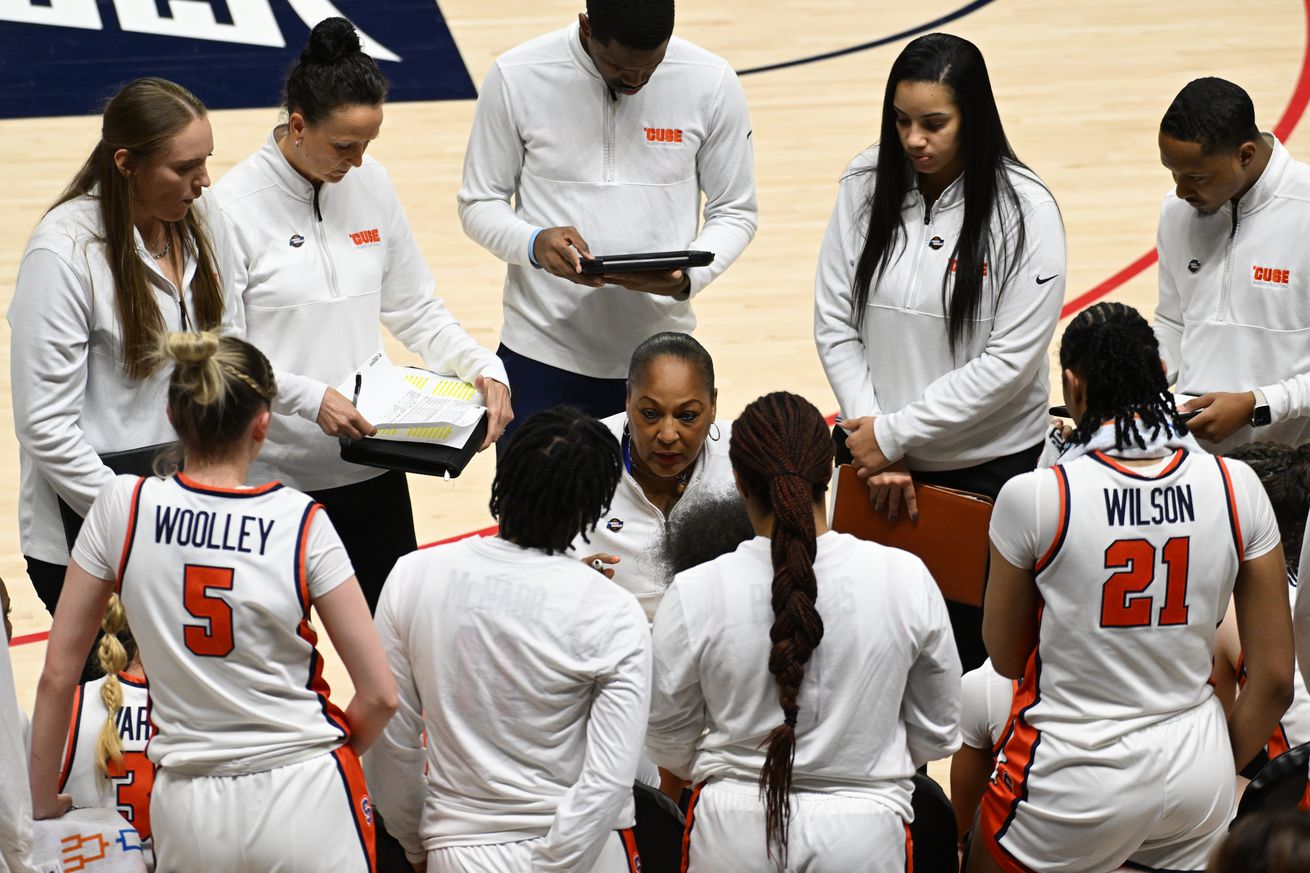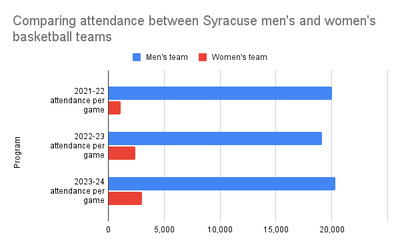
Despite recent success, attendance for Syracuse women’s basketball might still be a problem. Does the data back up that claim?
A new Syracuse Orange women’s basketball season is here, which means plenty of intrigue will revolve around the team as coach Felisha Legette-Jack looks to continue building momentum early in her tenure. Yet, a big question for the program looms incredibly large.
And to clarify, it’s not how will Syracuse perform offensively without Dyaisha Fair, can the Orange return to the NCAA Tournament again or is there a chance the team can beat Notre Dame again?
The real question that hasn’t been talked about pretty much at all leading up to this year: what’s to make of Syracuse women’s basketball attendance?
More specifically, a) does the program have an attendance ‘problem’ and b) is there any reasonable way to close the gap between the men’s and women’s team, as well as the rest of the ACC?
For context, the numbers across the board are… startling.
To be fully transparent: the full data for ACC women’s basketball attendance numbers only go back the past three years (2021-22 to 2023-24). So yes, we are dealing with a small sample size relative to a program which played its first season in the early eighties.
However, those numbers are still a bit concerning… and should be for the team, Syracuse Athletics and everyone in Orange Nation.
The one positive: attendance improved by a mile since Legette-Jack took over as head coach in 2022:
After ranking 11th in the conference in attendance in 2021-22, Syracuse saw its attendance for games improve by more than double each of the next two years. In the bigger picture, the Orange went from bottom-five in the conference to top-half in the ACC, which admittedly is an improvement. Yet again, it’s another testament to the work FLJ has done since returning to Syracuse to rebuild the program.
But even with Syracuse’s recent success, especially last year’s, the difference in average attendance between men’s and women’s basketball remains substantially large as seen here:

That’s a pretty stark difference between both programs. In a three-year stretch (2022 to 2024) where Syracuse’s men’s team had a combined average attendance of 19,801, the women’s team’s average never even cracked above 2,200.
To clarify, it’s also not like there was a significant gap in on-court performance for both programs as both the men’s team (53-44 overall, 30-30 in the ACC) and women’s team (55-39 overall, 28-28 in the ACC) are almost identical since 2022. On the women’s side, that also includes a major outlier: an 11-18 (4-14) campaign under Vonn Read in 2021-22, one year before FLJ took over.
Even scarier: if you look purely at average attendance for men’s and women’s basketball for all ACC programs last year, Syracuse actually has the largest gap between both its teams. And again, that differential is incredibly large compared to any other team in the conference outside of UNC:
Now, the above chart obviously does not take into account a pretty major factor: arena capacity. In the 2023-24 season and prior, the JMA Wireless Dome could hold 35,642 fans. It will now have a capacity of 30,219 with the new seating replacing the old bleachers.
One could argue Syracuse’s stadium capacity is just way more compared to any other ACC team, so of course it’s unfair to say the gap can be closed when the Dome can theoretically hold way more fans. After all, even factoring in the reduced seating capacity that’s now in effect, Syracuse would still have the largest of any other team in the ACC (including newcomers Stanford, California and SMU).
To at least contextualize the numbers, let’s break down a few more charts with all the data. This first one just looks at the percentage of attendance relative to stadium capacity (using the Dome’s old capacity, since we’re looking at years before the changes in seating). As the numbers show, that high capacity of the Dome weighs down Syracuse’s percentage of fans it can fill in the arena.
Now, what if we first try to theoretically slash the Dome’s capacity exactly in half (from 35,642 to 17,821. Here is how the percentage of arena number would change for Syracuse:
The percentage is at least slightly better… but is still bottom-six in the ACC.
To be as absolutely fair as possible, what if we even the playing field among all teams in the conference?
This chart below takes all the arena capacities for the ACC programs as of 2023-24, calculating that average and dividing it by average attendance per game to see whether Syracuse and the rest of the conference over- or under-filled its arena relative to the average arena size in the ACC (that number would be 13,156 — taking the average of all 15 values under the “arena capacity” column seen in the previous two charts):
Leveling the playing field, Syracuse would at least (barely) rank in the top-half in the conference in 2023-24 attendance. Just to build out the sample size just a bit, here’s what happens if we include attendance from 2021-22 and 2022-23 performing the exact same exercise as the chart above:
Based on those last three charts, this is the clear takeaway when the playing field is even with arena capacity: in the past three years, Syracuse’s attendance ranked bottom-five in 2021-22, tied for seventh in 2022-23 and seventh in 2023-24.
Should we consider that an attendance “crisis/problem”? Not necessarily, because there are indeed plenty of teams performing way worse.
Then again, there’s also some legit arguments those numbers should easily be better:
- Ticket prices shouldn’t really be much of a concern, at least on the women’s side. Assuming you are not an SU student (and therefore having the ability to get in for free), tickets for the general public for the upcoming year are as low as $9 but never go higher than $27, according to SeatGeek. On the men’s side, the first few games are around $3 during non-con and are roughly in the twenties for most of the ACC schedule. The only exceptions: a select few games are in the $60 to $70 range, like the Duke and UNC MBB home games.
- The significant interest in Syracuse basketball among fans. Even with a bigger capacity compared to pretty much any other ACC arena, having a roughly 16,000-fan difference between men’s and women’s games is… shocking. Again, it’s not like one team has vastly been way better than the other. If anything, last year’s women’s team was better than any other single-season Syracuse basketball team the past three years.
- Since Legette-Jack has taken over the program, the Orange are 29-6 (.829) in the Dome. So not only is their an on-court home advantage that is on the line, but at this point, there’s a better than 80% chance a home game equals a win. That’s also a better home winning percentage than the men’s team the past two years by just a bit (25-9, .735).
The main ‘challenge’ to fixing women’s basketball attendance is scheduling: almost all games are at least consistently on Thursday evening and Sunday (usually early afternoon). The downside: those are two pretty tough days in the week for most people to carve out time for a sporting event, and the Orange can’t do much really about switching the days around.
So, what can be done to fix all of this? Personally, I don’t have the answer. There’s a bunch of changes, small and big, which SU Athletics could look to do to help reduce the gap in attendance. That laundry list includes:
- Higher quantity and quality of local media coverage of the women’s team, which in turn could improve the national profile of the team and draw more interest
- Generally, more family deals to improve turnout among the local community and incentivize family-sized groups to go to the Dome
- Slashing WBB ticket prices in half
- Packaging a premier MBB game with a ‘top-tier’ WBB game
- I assume they’re trying their absolute best, but hoping Otto’s Army continues to invest in drawing interest among students for WBB and students following suit
- Mini Dome? Think Duke-style court that could help to make the arena feel a lot less empty and create an electric environment. Radical, but a thought with legit pros and cons
- A spring version of ‘School Day’ which always draws the highest-attendance crowd of the year
Again, progress is being made… but it’s also clear a lot more work can be done.